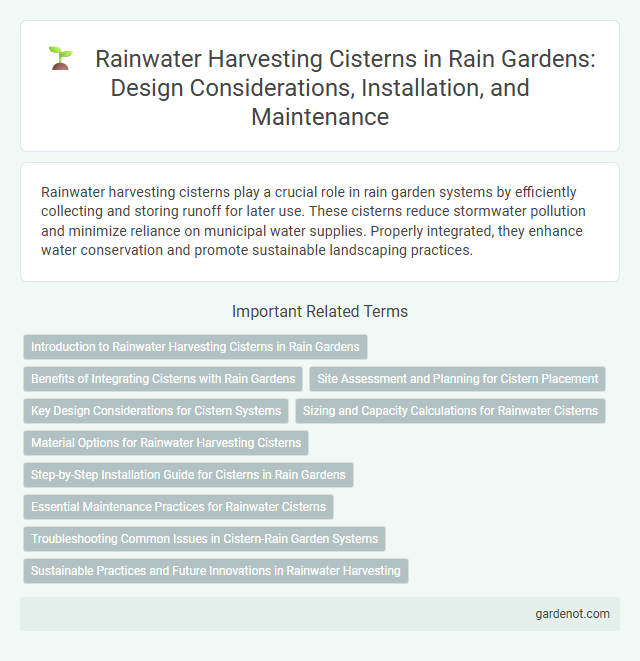Rainwater harvesting cisterns play a crucial role in rain garden systems by efficiently collecting and storing runoff for later use. These cisterns reduce stormwater pollution and minimize reliance on municipal water supplies. Properly integrated, they enhance water conservation and promote sustainable landscaping practices.
Introduction to Rainwater Harvesting Cisterns in Rain Gardens
Rainwater harvesting cisterns in rain gardens serve as essential storage systems that collect and store runoff from rooftops or impermeable surfaces, reducing stormwater overflow and erosion. These cisterns are typically made from durable materials such as polyethylene or concrete, designed to hold and slowly release captured rainwater to sustain plants in the rain garden. Incorporating rainwater harvesting cisterns enhances water conservation efforts, promotes groundwater recharge, and supports sustainable landscape management.
Benefits of Integrating Cisterns with Rain Gardens
Integrating rainwater harvesting cisterns with rain gardens enhances water conservation by capturing and storing runoff for later use, reducing reliance on municipal water supplies. This synergy improves stormwater management, minimizing flooding and erosion while promoting groundwater recharge. Stored rainwater supports garden irrigation, maintaining plant health and increasing the sustainability of urban landscaping.
Site Assessment and Planning for Cistern Placement
Site assessment for rainwater harvesting cistern placement involves evaluating soil type, topography, and drainage patterns to ensure optimal water collection and system efficiency. Planning considers proximity to downspouts, slope stability, and accessibility for maintenance, maximizing cistern functionality while minimizing overflow risks. Proper siting integrates local rainfall data and environmental regulations to enhance sustainable water management.
Key Design Considerations for Cistern Systems
Rainwater harvesting cistern systems require careful attention to site selection, ensuring proximity to downspouts and stable ground for installation. Material durability and capacity must align with anticipated rainfall volume and intended water use, optimizing storage efficiency. Incorporating overflow mechanisms and filtration units enhances water quality and prevents system damage during heavy precipitation events.
Sizing and Capacity Calculations for Rainwater Cisterns
Rainwater harvesting cistern sizing depends on roof catchment area, average rainfall, and water demand to ensure adequate storage capacity. Calculations involve determining the volume by multiplying catchment area by rainfall depth and adjusting for collection efficiency and desired retention period. Properly sized cisterns optimize rainwater utilization for irrigation, reducing runoff and supporting sustainable water management in rain gardens.
Material Options for Rainwater Harvesting Cisterns
Rainwater harvesting cisterns are commonly constructed from materials such as polyethylene, fiberglass, and concrete, each offering unique durability and maintenance benefits. Polyethylene cisterns are lightweight and corrosion-resistant, making them ideal for residential use, while fiberglass provides strength and longevity with low permeability. Concrete cisterns are durable and suitable for large-scale storage but require proper sealing to prevent leakage and contamination.
Step-by-Step Installation Guide for Cisterns in Rain Gardens
Installing a rainwater harvesting cistern in a rain garden begins with selecting an appropriate location near the garden to capture runoff efficiently. Excavate a level, stable area to place the cistern and install a pre-filter or debris guard on the downspout to prevent clogging. Connect the downspout to the cistern inlet, secure overflow piping, and ensure the outlet allows excess water to flow into the rain garden for optimal water management.
Essential Maintenance Practices for Rainwater Cisterns
Regular inspection and cleaning of rainwater harvesting cisterns prevent debris buildup and contamination, ensuring efficient water storage. Installing and maintaining first-flush diverters and gutter guards reduce sediment and pollutant entry into the cistern. Routine checks for leaks, valve functionality, and the integrity of tank seals safeguard the stored water quality and prolong the system's lifespan.
Troubleshooting Common Issues in Cistern-Rain Garden Systems
Clogged inlet filters and overflow pipes frequently impede the efficiency of cistern-rain garden systems, causing water backup and potential damage to the rain garden. Regular inspection and cleaning of debris from screens, gutters, and downspouts are essential for maintaining optimal water flow and preventing contamination. Addressing leaks promptly and ensuring proper sealing of joints helps preserve water quality and system integrity in rainwater harvesting setups.
Sustainable Practices and Future Innovations in Rainwater Harvesting
Rainwater harvesting cisterns play a crucial role in sustainable water management by capturing and storing runoff for irrigation and household use, significantly reducing dependency on municipal water supplies. Modern cistern designs incorporate advanced filtration systems and automated monitoring technology to enhance water quality and optimize storage capacity. Future innovations focus on integrating smart sensors and IoT connectivity to enable real-time water usage analytics and adaptive harvesting strategies, promoting greater efficiency and environmental conservation.
Rainwater harvesting cistern Infographic

 gardenot.com
gardenot.com